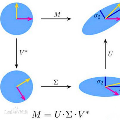Unlike the field of visual scene recognition where tremendous advances have taken place due to the availability of very large datasets to train deep neural networks, inference from medical images is often hampered by the fact that only small amounts of data may be available. When working with very small dataset problems, of the order of a few hundred items of data, the power of deep learning may still be exploited by using a model pre-trained on natural images as a feature extractor and carrying out classic pattern recognition techniques in this feature space, the so-called few-shot learning problem. In regimes where the dimension of this feature space is comparable to or even larger than the number of items of data, dimensionality reduction is a necessity and is often achieved by principal component analysis, i.e., singular value decomposition (SVD). In this paper, noting the inappropriateness of using SVD for this setting, we usher in and explore two alternatives based on discriminant analysis and non-negative matrix factorization (NMF). Using 14 different datasets spanning $11$ distinct disease types, we demonstrate that discriminant subspaces at low dimensions achieve significant improvements over SVD-based subspaces and the original feature space. We also show that NMF at modest dimensions is a competitive alternative to SVD in this setting.
翻译:暂无翻译



